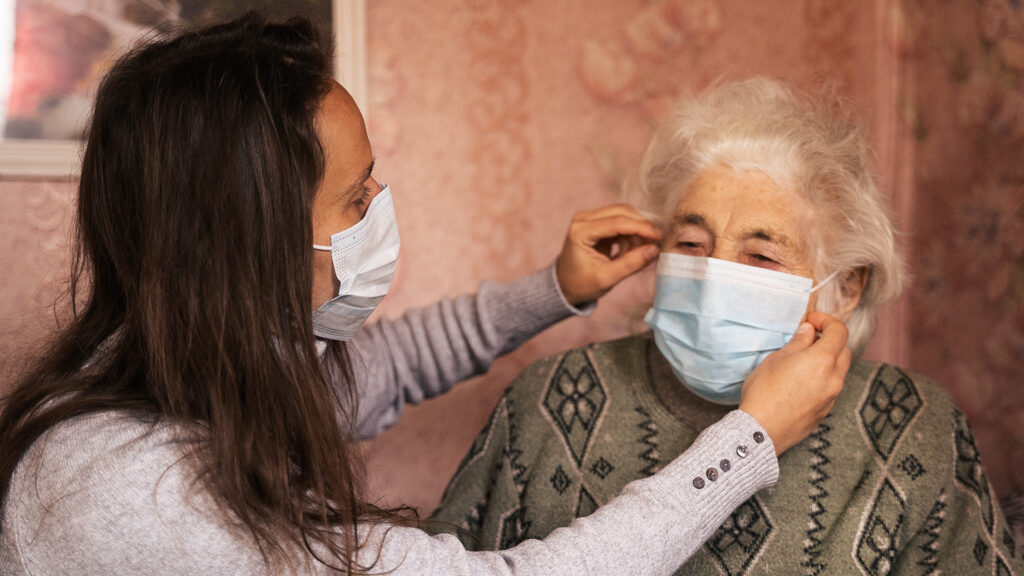
The workloads of women increase in the COVID-19 pandemic because they predominantly take care of the elderly and the sick. Photo: Daniel Balakov / Getty Images.
It is a convenient assumption that diseases do not acknowledge social boundaries and barriers. In reality, Covid-19 is throwing social and gender inequalities in stark relief at different scales of social life. It is crucial to address this at the forefront of the fightback, as the pandemic has already revealed how persistent inequalities are exacerbated and created in the face of the public health crisis.
Furthermore, state-mandated shutdowns can inadvertently compound the risks experienced by vulnerable populations, as power dynamics are magnified behind a veil of privacy. Lockdowns have already brought a steep rise in domestic violence, where the abused are overwhelmingly women and children, and it’s harder for victims to get away from perpetrators and access social protection services, such as violence and abuse shelters.
The pandemic has also shone a harsh light on the unequal workloads and economic hardships borne by different groups. With schools closed, the elderly sheltered, and the sick quarantined at home, the pandemic is increasing women’s domestic and family workload and exposing them to greater health risks.
And the inequity of care work extends beyond the household into the formal labour market: while women represent 70% of the global health workforce (in Hubei Province in China, it is as high as 90%) they are severely underrepresented in global health leadership and decision-making, meaning that public health policy does not properly reflect women’s needs.
Societal divides are sharpened by the question of who can afford to “socially distance” themselves, at the risk of reduced or no pay, and who can work from home and who cannot. This is largely a class-based divide, and those identified as “key workers” in the fight against Covid-19 often have the least financial security and protection from infection. In many parts of the world, the healthcare workforce is not only highly gendered, it is also racialized, which is further reflected in the class-based workforces to be found in many other key provisioning sectors, such as grocery stores, manufacturing and logistical work.
Societal divides are sharpened by the question of who can afford to “socially distance” themselves, at the risk of reduced or no pay, and who can work from home and who cannot. #COVID-19
Share on XPrecarity extends to other service providers, such as gig workers, who perform risky services such as delivering necessities, yet are struggling financially without social insurance and union support. Migrant workers, who carry out a large percentage of informal and manual labour, are being left jobless and faced with the threat of closing borders.
Furthermore, homeless people are highly at risk as they are forced into close proximity with others in shelters, and those without shelter may face punishment amid lockdown measures. And in some places, profit-driven healthcare systems are raising the costs of virus testing, protection, and intervention, thus increasing divides between who gets care and who does not, with the most susceptible groups barred from adequate health services.
Functioning social protection systems that are ready to respond to disasters are obviously necessary to combat the Covid-19 crisis. However, if governments fail to consider gender, race and class-based inequalities as they pass laws and build stimulus packages, vulnerable groups, such as victims of abuse, migrant and frontline workers, and those in precarious and informal employment, will be further marginalized.
We need to rethink the neoliberal dynamics that shape precarity and social vulnerability. This could mean that stimulus packages and economic bailouts prioritize citizens’ well-being over profit. While in many instances, communities have already demonstrated their ability to engage and fill the gaps that the state cannot or will not fill, there is also a risk that repressive measures taken in the face of the pandemic, such as those enacted in Hungary, could restrict the space for people to reclaim or maintain their human and environmental rights.
It is crucial that in a time of crisis citizens are engaged, vigilant about human rights, and hold public institutions to account for responsive action and social protection. But this is not enough on its own: the crisis is also a wake-up call to strengthen our connectivity and care for each other through our institutions and daily practices.
The Covid-19 pandemic is exposing existing inequalities and places us at a moment of reckoning: do we return to business as usual, defined by the structures that drive inequalities worsened by climate change, environmental and health crises, or transition to more caring, humane, and just societies?
Design and development by Soapbox.